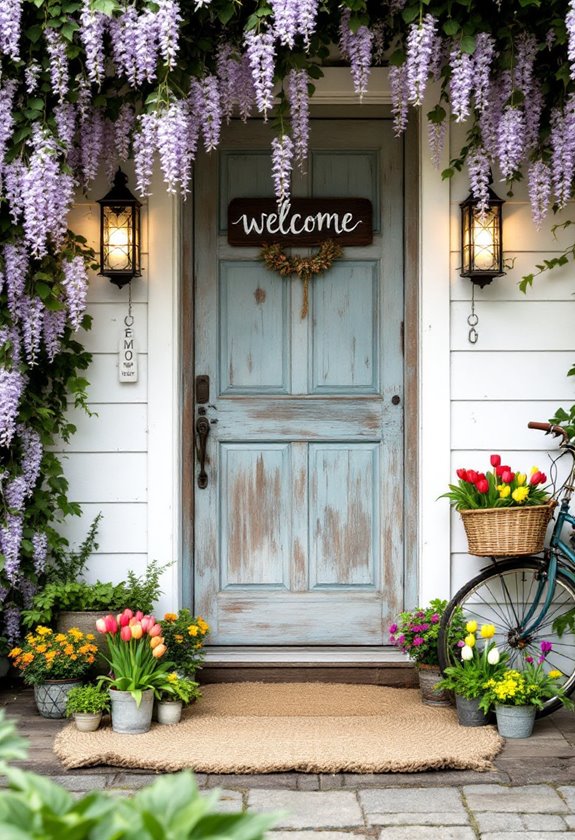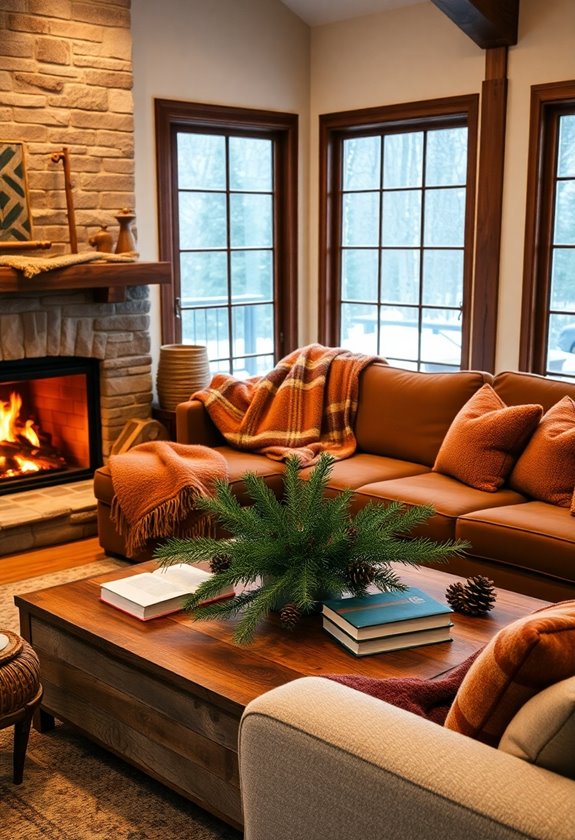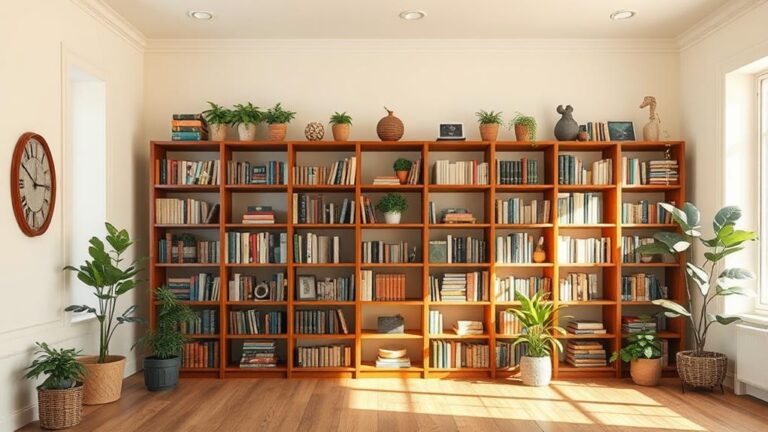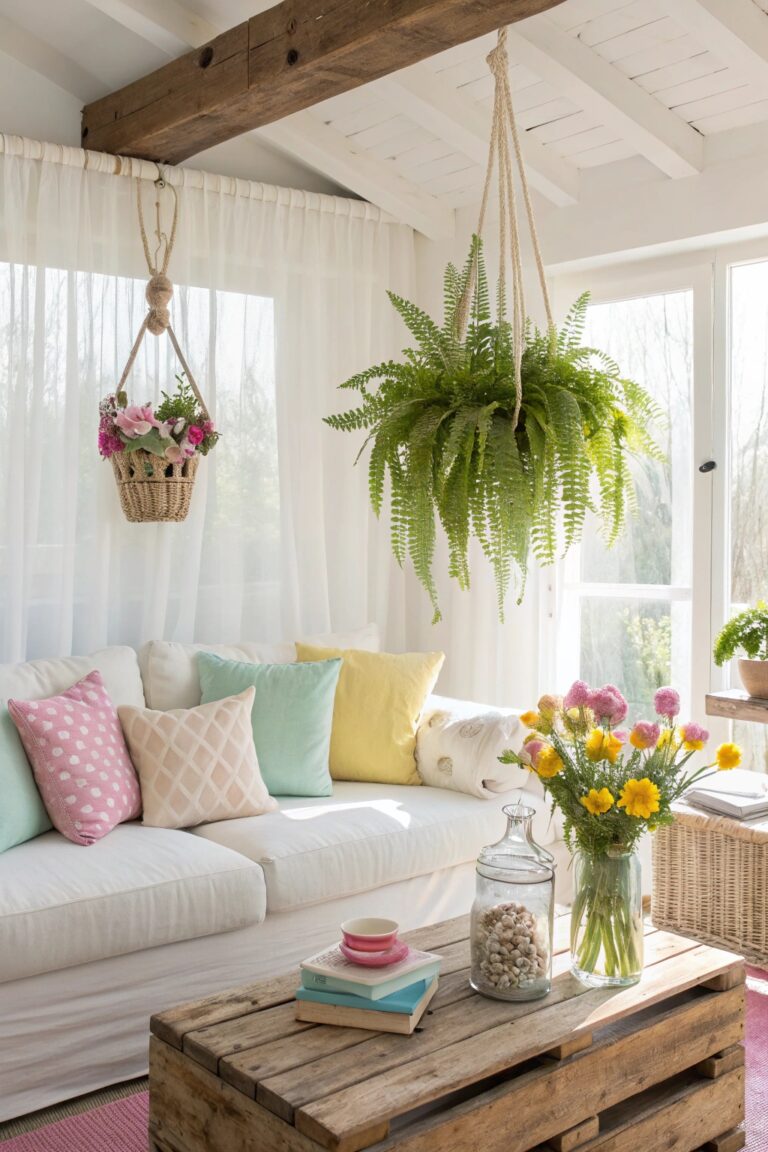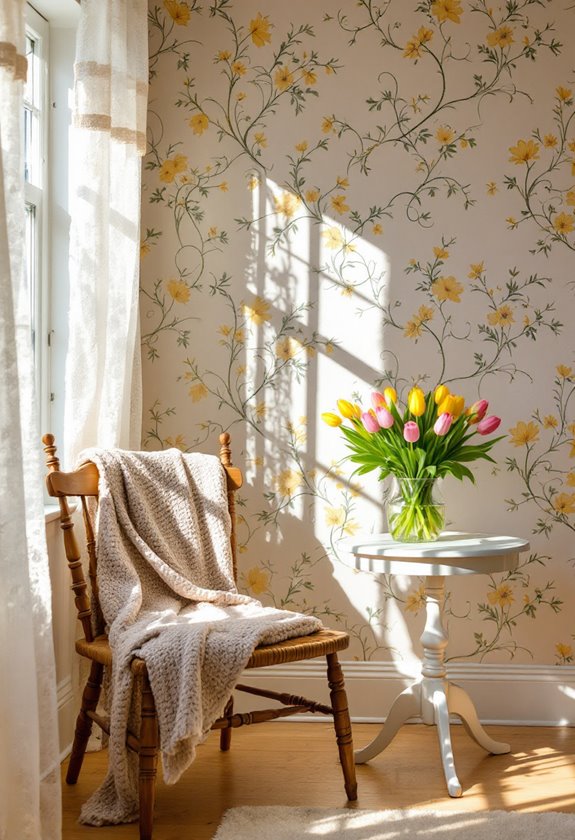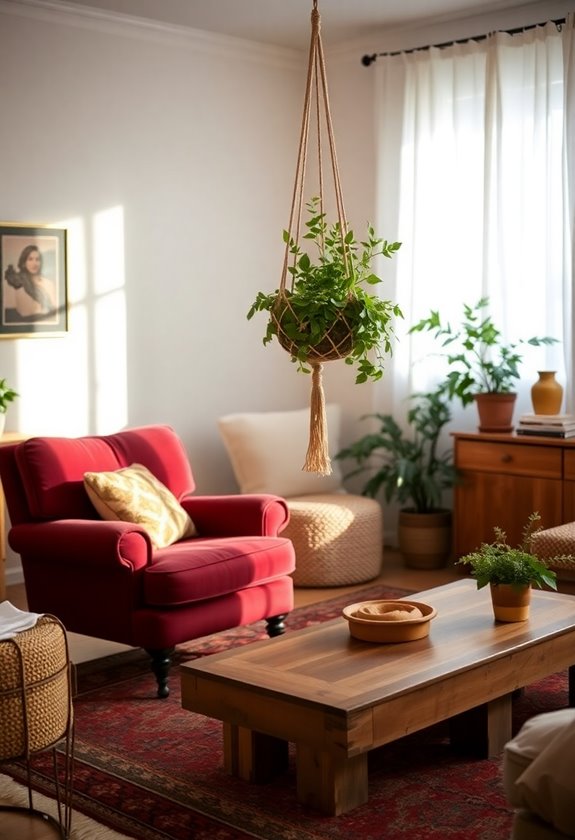Creating a whimsical sensory wall for your baby can be both fun and beneficial for their development. I've found that incorporating a mix of textures, sounds, and colors can really stimulate their senses. Think about using textured fabric squares, crinkly paper, and even sound-making instruments. Each element serves a purpose in fostering creativity and fine motor skills. If you're curious about the specific materials and how to assemble them, I've got some great ideas to share with you!
Textured Fabric Squares
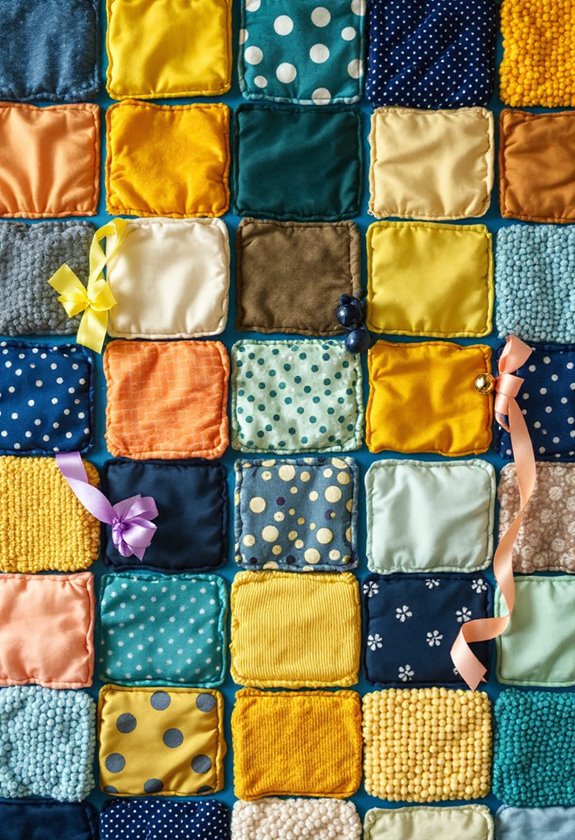
When it comes to creating a sensory wall for babies, textured fabric squares are a fantastic choice that can engage little ones while promoting sensory exploration.
I love using a variety of textiles, like soft fleece, bumpy corduroy, and shiny satin. This textile variety not only captivates their attention but also invites them to touch and feel different surfaces, enhancing their tactile senses.
I recommend mixing various shapes and sizes to keep things interesting. You can easily attach these squares to a board or wall, ensuring they're securely fastened.
This hands-on experience encourages curiosity and sparks joy in discovery for your baby!
Colorful Ribbons and Streamers
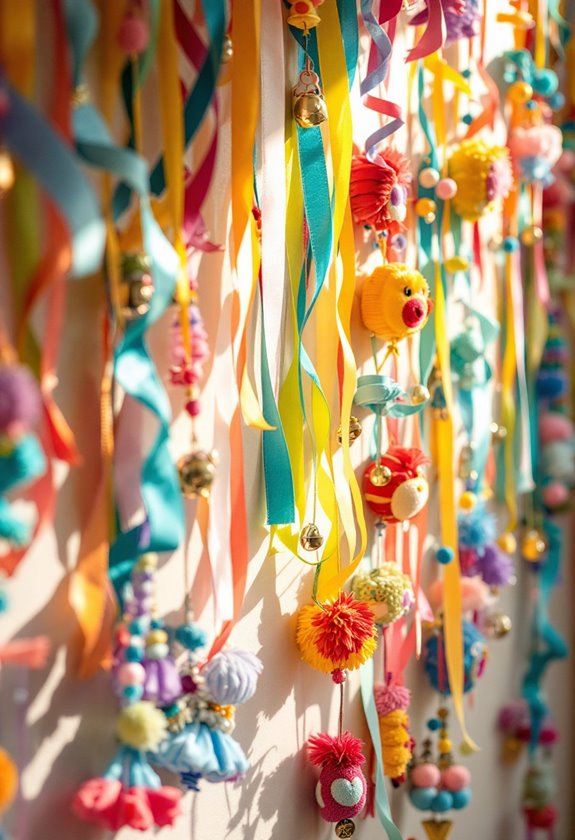
Colorful ribbons and streamers can add a vibrant touch to your sensory wall, capturing your baby's attention with their playful movement and bright hues.
I love incorporating various ribbon textures, like satin and burlap, which not only look great but also feel intriguing for tiny hands to explore.
Hang the ribbons at different lengths to encourage streamer movement, creating an enchanting visual display. As your baby reaches out to touch and pull on them, they'll develop fine motor skills and hand-eye coordination.
Sensory Bottles
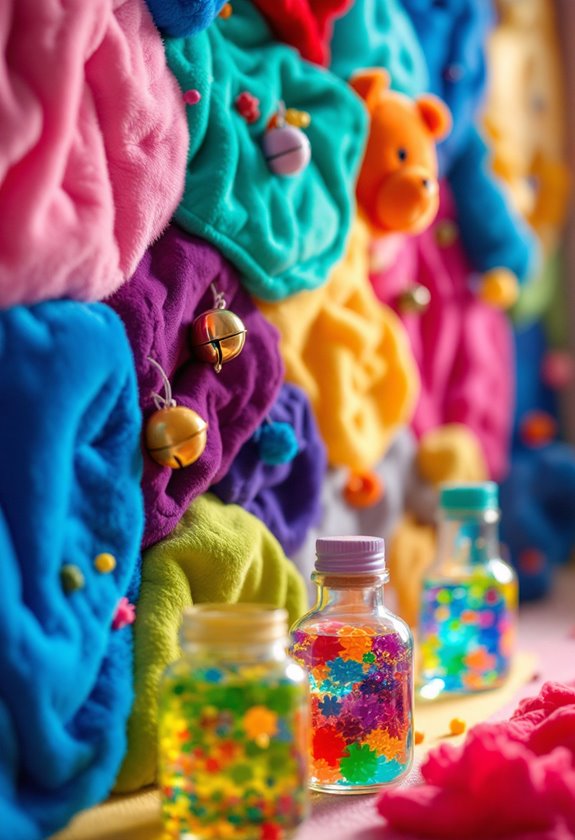
Sensory bottles are a fantastic addition to your baby's sensory wall, offering an engaging way for them to explore different textures and movements.
I love creating these bottles because they're simple and fun! Here are a few ideas for bottle filling:
- Water and glitter: It mesmerizes babies as they watch the glitter swirl.
- Rice and small toys: It encourages tactile sensory exploration as they shake and listen.
- Oil and colored water: The layers create a stunning visual effect that captivates little ones.
Making sensory bottles is an innovative way to enhance your baby's sensory wall and stimulate their curiosity!
Crinkly Paper Panels
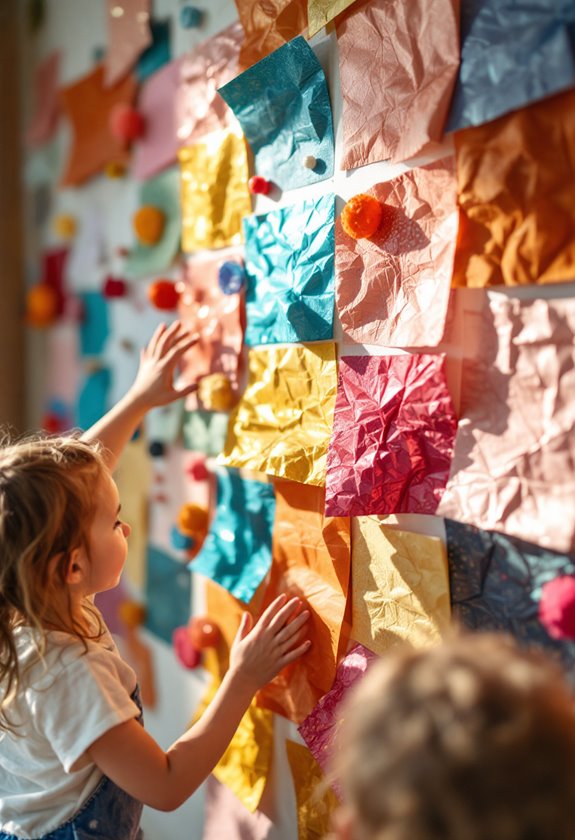
Crinkly paper panels are another delightful feature you can add to your baby's sensory wall.
These panels introduce amazing crinkly paper textures that spark curiosity and engagement. I love using materials like crinkly food wrappers or specialty craft paper, as they create an enticing sound that captivates little ones.
You can easily attach these sound-producing panels onto your wall, encouraging your baby to explore by touching and crumpling them. The combination of the unique textures and sounds not only entertains but also aids in sensory development.
Sound-Making Instruments
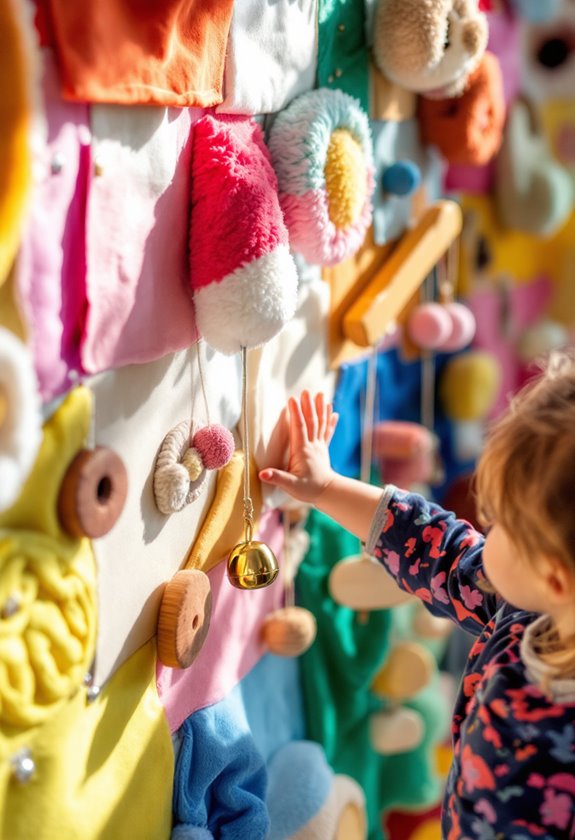
Incorporating sound-making instruments into your baby's sensory wall can truly elevate their playtime experience.
These musical instruments not only encourage sound exploration but also stimulate curiosity. Here are some ideas to get you started:
- Handmade shakers using rice and small containers.
- Mini tambourines for those delightful jingles.
- Wind chimes to create soothing sounds.
When you introduce these elements, your little one will engage with different noises, enhancing their sensory development.
Plus, it's a fantastic way to foster a love for music early on. Let's create a world of sound that sparks joy and discovery!
Velcro Strips and Shapes
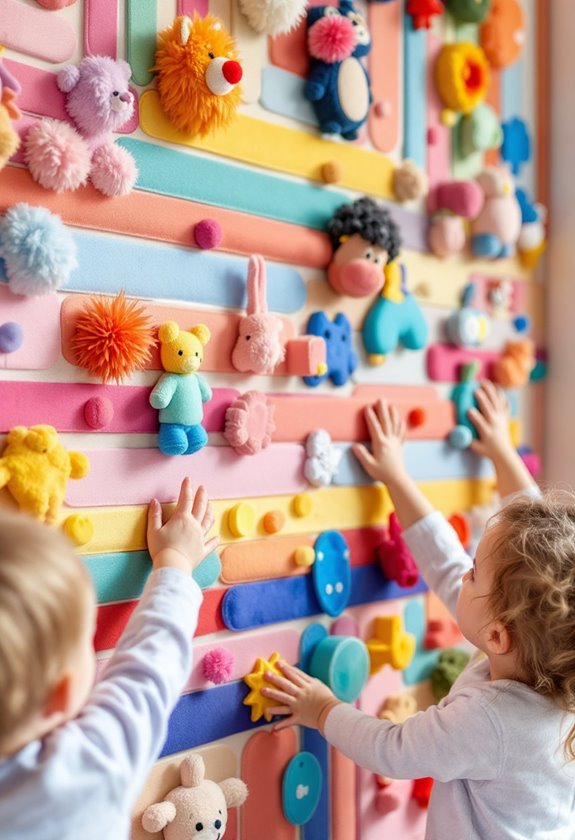
Creating a vibrant sensory wall for your baby can be both fun and rewarding, especially when you add Velcro strips and shapes into the mix.
I love using Velcro shapes to create interactive designs that spark curiosity. You can attach various Velcro textures, like soft felt or bumpy rubber, to engage your baby's sense of touch.
Experiment with different Velcro patterns to encourage exploration; a bright star or a colorful circle can catch their eye.
Plus, changing Velcro designs is a breeze! This flexibility keeps the sensory wall fresh, ensuring your little one stays excited and engaged with their environment.
Nature-Inspired Elements
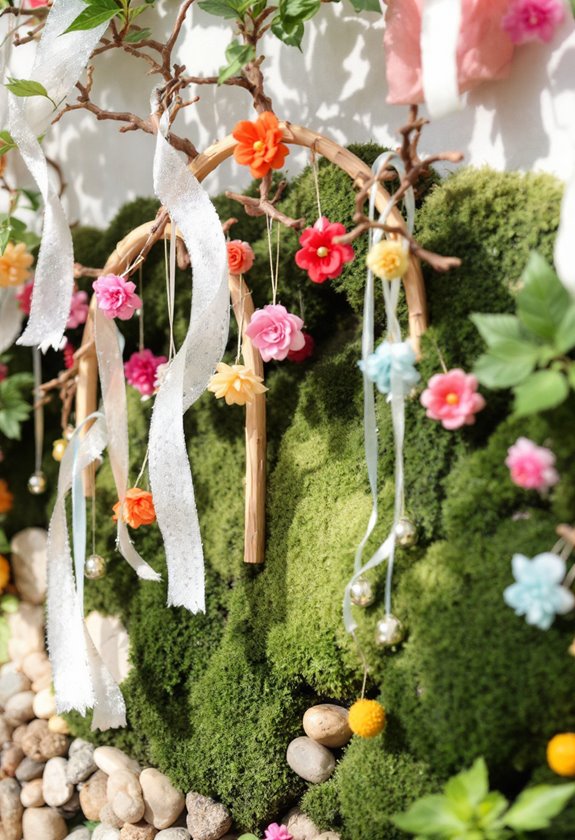
Adding nature-inspired elements to your baby's sensory wall can truly enhance their exploration of the world around them.
I love incorporating nature textures and outdoor sounds to stimulate their senses. Here are a few ideas to get you started:
- Use natural materials like leaves, twigs, or even small pinecones for tactile engagement.
- Create a mini sound box with nature sounds, like chirping birds or rustling leaves, to soothe and intrigue.
- Attach fabric swatches with different nature patterns to encourage visual exploration.
These elements not only engage your baby's senses but also foster a deeper connection to the beauty of nature.
Bubble Wrap Patches
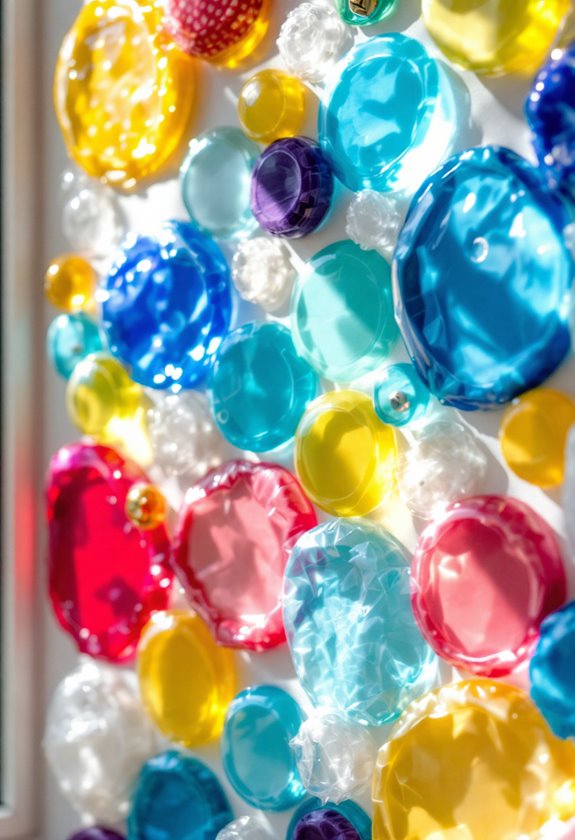
While nature-inspired elements add a lovely touch to a sensory wall, bubble wrap patches bring a whole new level of fun and engagement.
I love incorporating bubble wrap because the benefits go beyond just popping! Babies enjoy the tactile sensation, which helps develop their fine motor skills.
Plus, the sound of the bubbles bursting adds an exciting auditory element that keeps them intrigued.
When creating your sensory wall, consider varying the sizes of bubble wrap patches for even more bubble wrap fun.
It's a simple, innovative way to stimulate your baby's senses while encouraging exploration and play.
Pompom Pathways
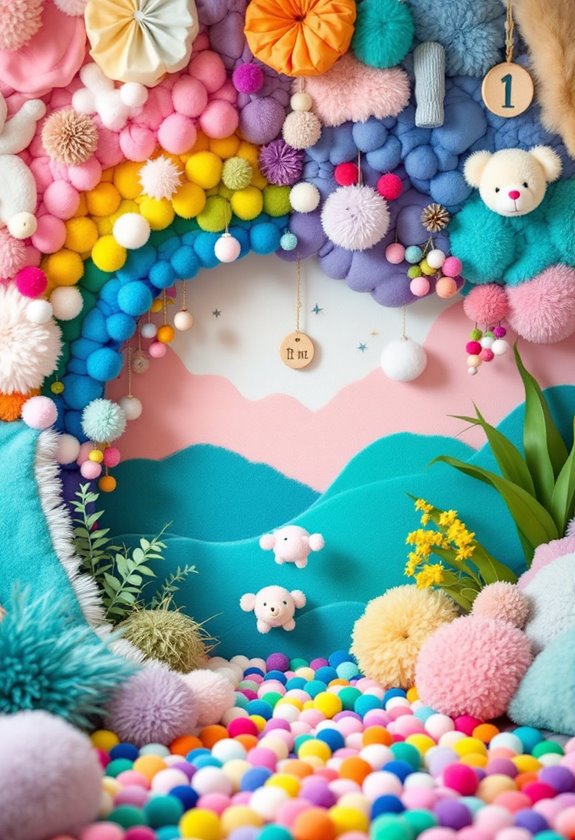
As I explore the world of sensory play, I find that pompom pathways can be a delightful addition to any sensory wall. These colorful pathways invite babies to touch and explore, sparking their curiosity.
By using various pompom colors and textures, you can create a vibrant experience. Consider these ideas:
- Mix soft, fuzzy pompoms with shiny, smooth ones for contrast.
- Arrange them in a winding path to encourage movement.
- Incorporate different sizes to stimulate tactile exploration.
Creating a pompom pathway not only enhances sensory engagement but also adds a whimsical touch to your sensory wall, making it a truly enchanting space for your little one.
Mirror Tiles
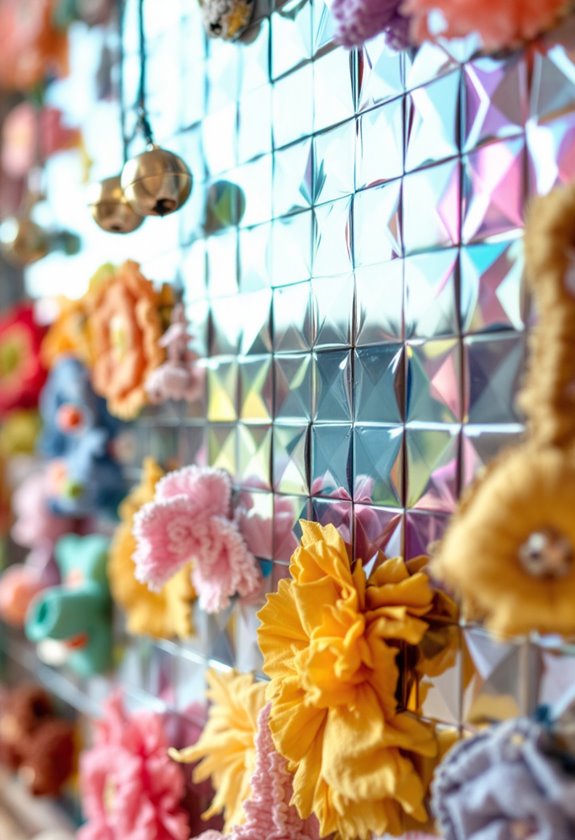
Mirror tiles can be a fantastic addition to your sensory wall, providing babies with a unique opportunity to explore their own reflections.
These reflective surfaces not only captivate little ones but also encourage self-recognition and interaction.
When selecting mirror tiles, always consider mirror safety to guarantee they're made from shatterproof materials to keep your baby safe.
I've found that arranging tiles at various angles adds an extra layer of visual interest, sparking curiosity.
Plus, the play of light on these tiles can also enhance the sensory experience.
Embrace the magic of mirrors; your baby will love it!
Felt Board Fun
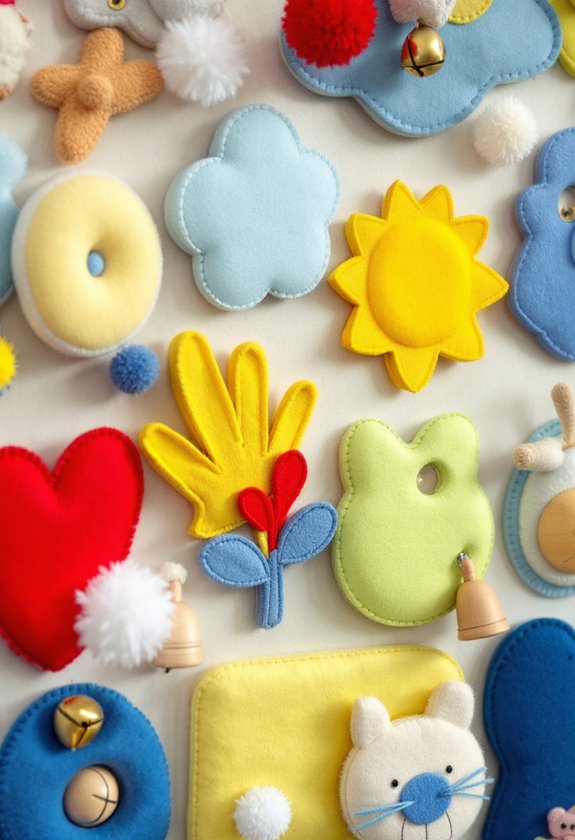
Creating a felt board is a fun and engaging way to enhance your baby's sensory wall. I love how versatile it's for sparking creativity!
You can easily make colorful felt board characters and shapes that invite your little one to explore. Here are some ideas to get you started:
- Animal shapes: Create felt versions of their favorite animals.
- Story characters: Design characters from beloved stories for interactive play.
- Shapes and colors: Use different felt board shapes to teach colors and sizes.
This hands-on activity not only boosts sensory development but also makes learning enjoyable for your baby!
Wooden Blocks
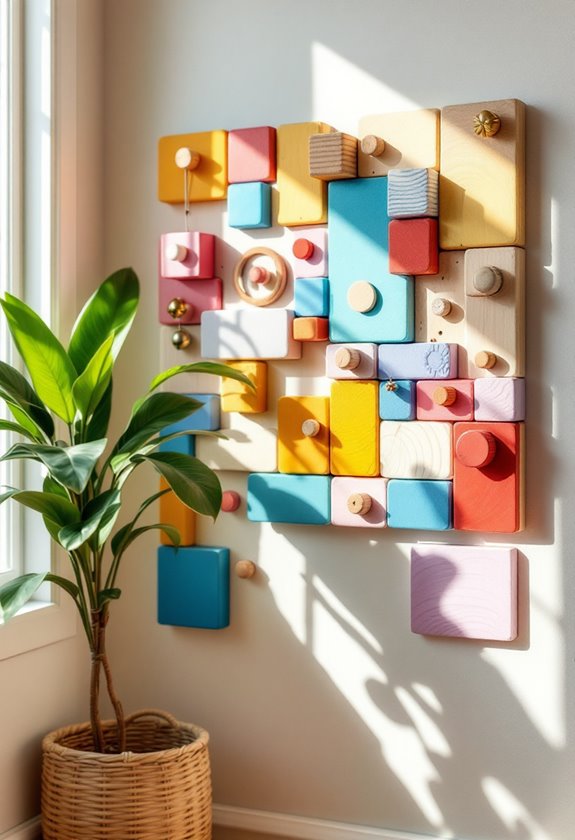
Wooden blocks are a classic addition to any sensory wall and can offer endless opportunities for exploration and learning.
I love incorporating wooden block stacking into my sensory setup; it's a fantastic way for babies to develop their motor skills while having fun.
You can also release creativity by introducing block painting—just grab some non-toxic paint and let your little one transform those blocks into colorful masterpieces.
The combination of textures and colors captivates their attention, encouraging imaginative play.
Plus, it's a simple DIY project that fosters both engagement and creativity, making it an essential element of any sensory wall!
Light-Up Sensory Features
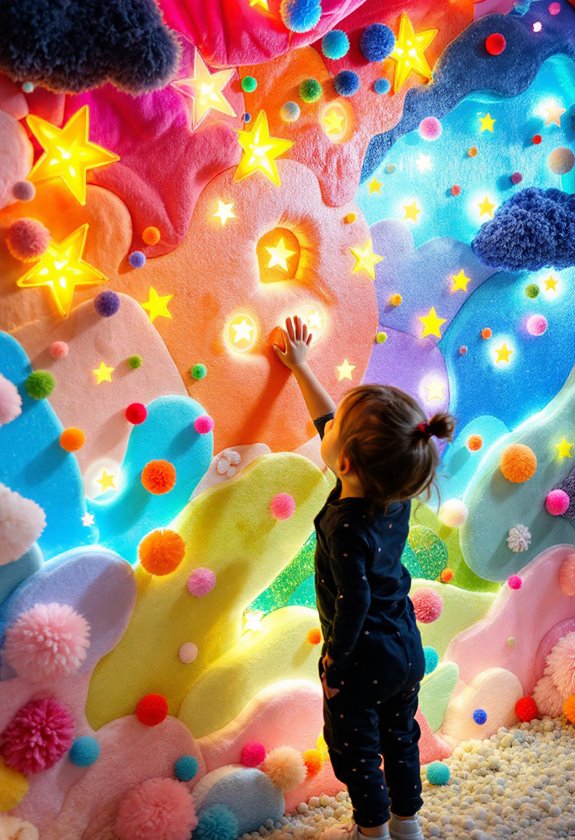
Adding light-up sensory features to a sensory wall can truly enhance the experience for babies, creating an engaging environment that stimulates their curiosity.
I recommend incorporating glowing accents that capture their attention and evoke wonder. Here are a few ideas to get you started:
- Light up stars that twinkle and change colors, mimicking a night sky.
- Illuminated pathways that let babies explore light in a fun way.
- Glow-in-the-dark elements that activate when the lights go out, sparking excitement.
These features not only brighten the space but also provide a unique sensory experience that encourages exploration and learning.
Scented Fabric Pouches
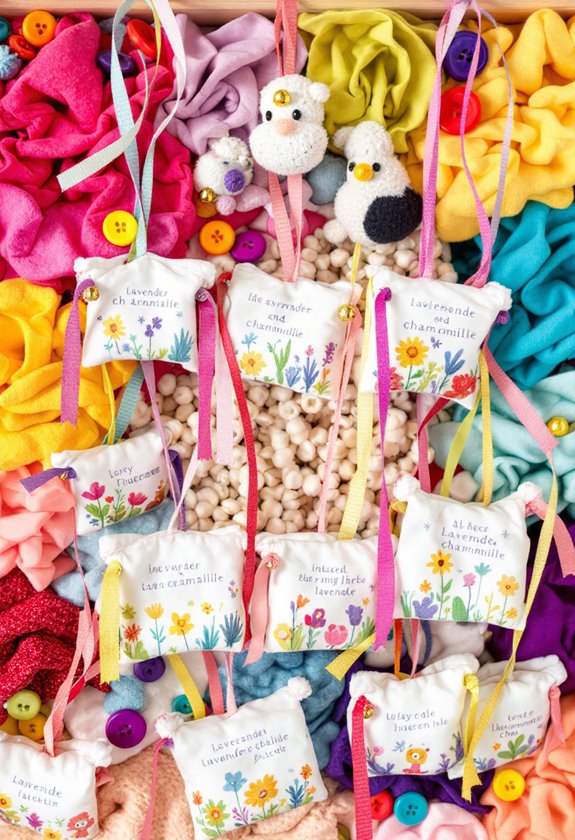
One delightful addition you can make to your sensory wall is scented fabric pouches, which offer a wonderful way to engage babies' sense of smell.
I love creating scented lavender pouches filled with dried lavender for a calming experience. Alternatively, you can craft citrus aroma bags using dried orange or lemon peels, bringing a cheerful, invigorating scent into playtime.
Just make certain the pouches are securely stitched to avoid any spills. Hang them at different heights, allowing your little one to explore these lovely fragrances safely.
It's a simple yet innovative touch that adds depth to your sensory wall masterpiece!
Sensory Pathways With Different Materials
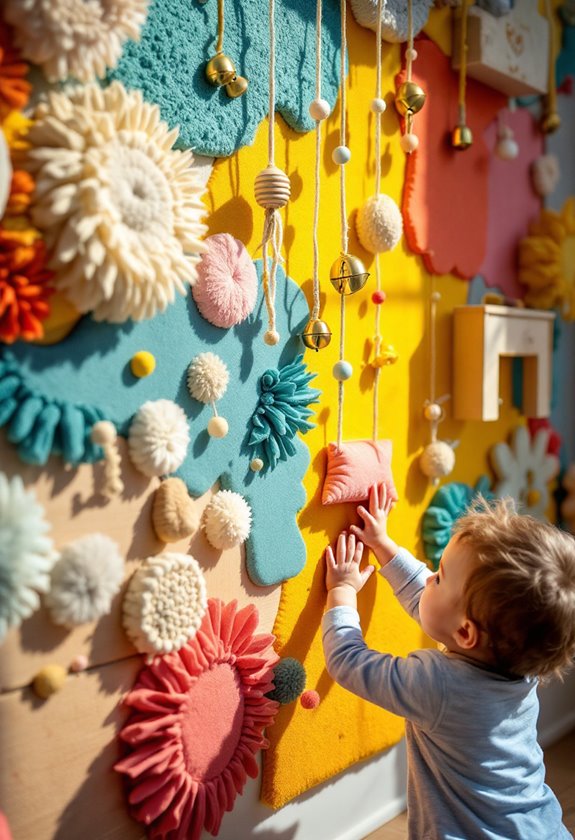
Creating sensory pathways with different materials can be an exciting way to enhance your baby's exploration and playtime. By incorporating various textures, you'll support sensory integration and encourage texture exploration.
Here are some innovative materials to reflect upon:
- Foam tiles for a soft, squishy feel
- Sandpaper for a rough, stimulating experience
- Faux fur for a cozy, warm touch
Each element invites your little one to crawl, touch, and discover.
This hands-on approach not only keeps them engaged but also fosters their sensory development. Let your creativity shine as you design a unique pathway tailored for your baby!
Water Beads Display
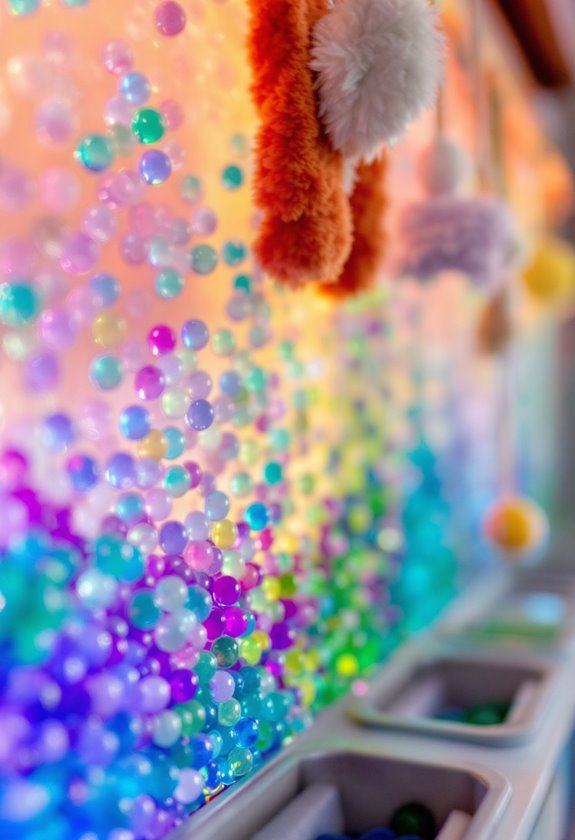
After exploring various textures in sensory pathways, it's time to introduce an engaging element that can captivate your baby's attention: water beads.
These colorful, squishy beads offer amazing water bead benefits, like enhancing fine motor skills and sensory exploration. As your baby squeezes and rolls them, they'll discover new sensations, making playtime delightful.
However, water bead safety is essential; always supervise your little one, as they can be a choking hazard if swallowed.
To create a display, fill a clear container with water beads, letting your baby marvel at their vibrant colors while enjoying the tactile experience. It's a win-win!
Interactive Zippers and Buttons
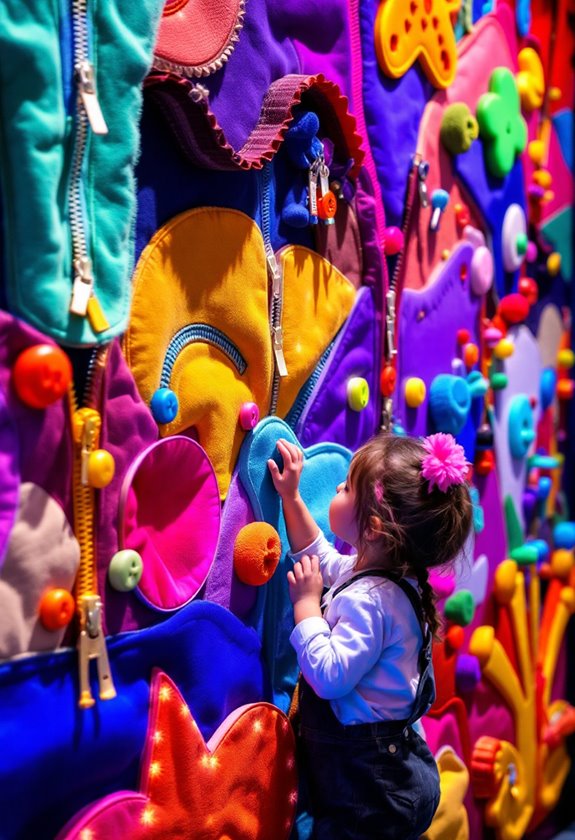
Interactive zippers and buttons can be a fantastic addition to your baby's sensory wall, providing them with hands-on experiences that promote fine motor skills and cognitive development.
As I created my wall, I discovered how zippers exploration and button manipulation can captivate little ones.
Here are some innovative ideas to incorporate:
- Use colorful zippers of varying lengths for tactile fun.
- Attach different sizes of buttons, encouraging your baby to practice grasping and pressing.
- Create a small pocket with a zipper, making it a surprise bag for toys.
These elements not only enhance engagement but also nurture your baby's curiosity and dexterity.
Tactile Puzzles
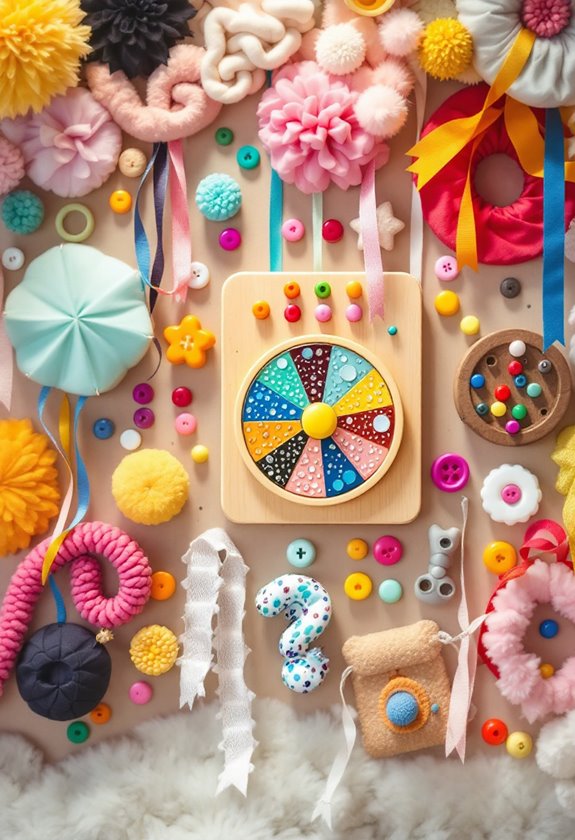
Adding tactile puzzles to your sensory wall can bring a new layer of excitement and learning for your baby. These innovative puzzles encourage tactile exploration, allowing little hands to feel different textures while solving problems.
Choose puzzles with varied materials, such as soft fabrics, bumpy surfaces, or smooth wood, to spark curiosity. I love incorporating puzzle play into our daily routine, as it promotes fine motor skills and cognitive development.
You can even create themed puzzles, like animals or shapes, to make it more engaging. Watching my baby interact with these tactile puzzles is a joy, fostering creativity and critical thinking!
Color-Changing LED Lights
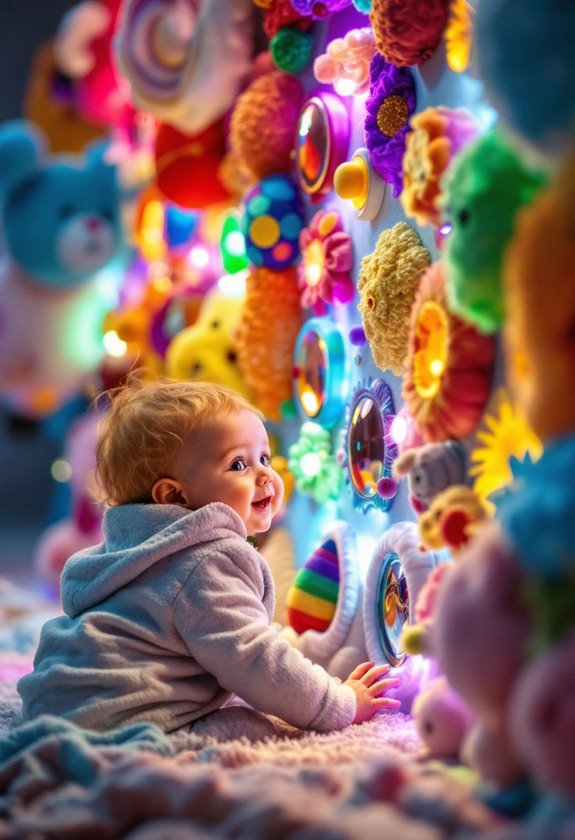
One fantastic addition to your sensory wall is color-changing LED lights, which can captivate your baby's attention and enhance their visual experience.
These mesmerizing lights create a dynamic atmosphere that encourages exploration.
Here are a few ways to use them effectively:
- Choose lights with adjustable brightness to suit different moods.
- Install them in various shapes to add an artistic flair.
- Sync the colors with your baby's movements for interactive play.
Sound Buttons and Recordings
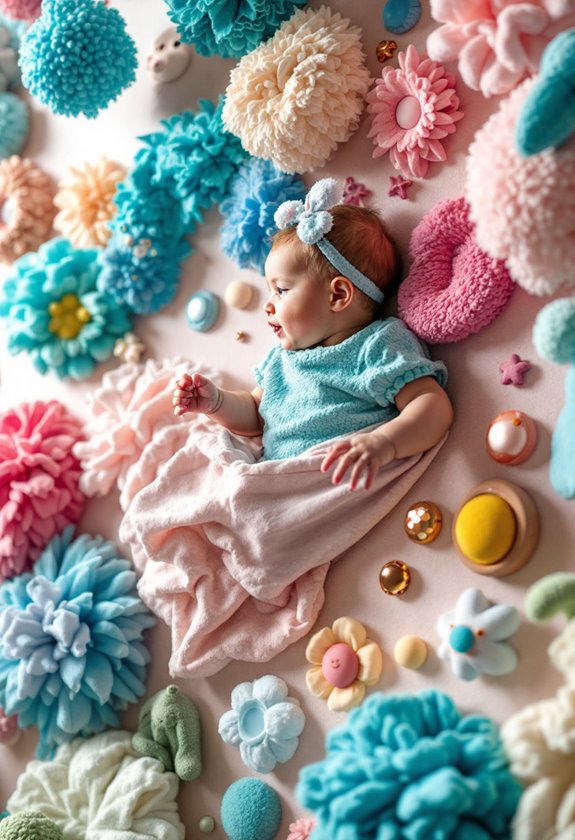
While creating a sensory wall for your baby, incorporating sound buttons and recordings can truly elevate the experience. These elements invite sound exploration, making your wall not just visual but auditory too.
You can easily find recordable buttons online, allowing you to capture your voice or favorite sounds. Imagine your baby giggling as they press a button and hear a cheerful tune or a gentle animal sound.
This auditory stimulation is essential for developing their listening skills and understanding cause and effect. Plus, it adds a personal touch to the sensory wall, making playtime even more engaging and memorable!
DIY Sensory Garden Elements
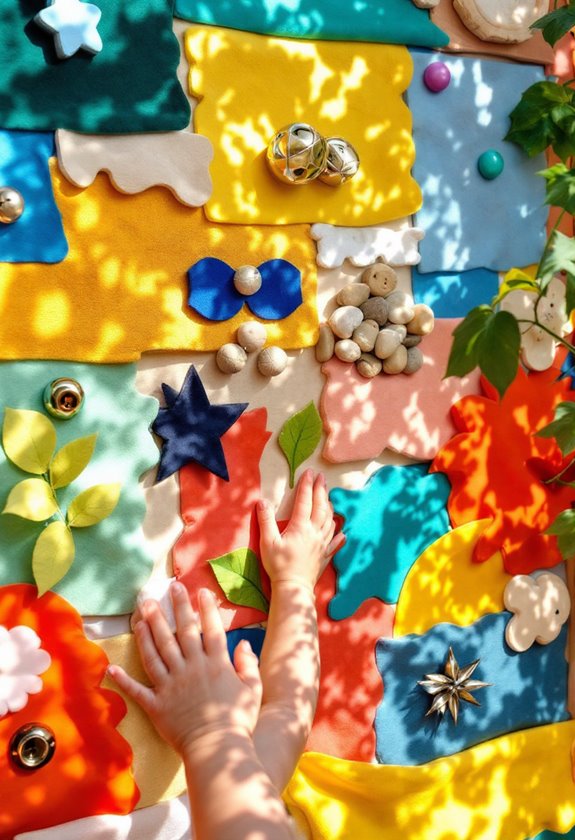
Creating a sensory garden can be a wonderful addition to your baby's sensory wall, bringing the experience of nature right into your home.
I love incorporating sensory garden plants that stimulate curiosity and promote outdoor exploration. Here are a few ideas to get you started:
- Aromatic herbs like basil or mint can engage your baby's sense of smell.
- Textured leaves from plants like lamb's ear or fuzzy sage offer tactile fun.
- Colorful flowers such as marigolds or pansies can captivate their visual senses.

